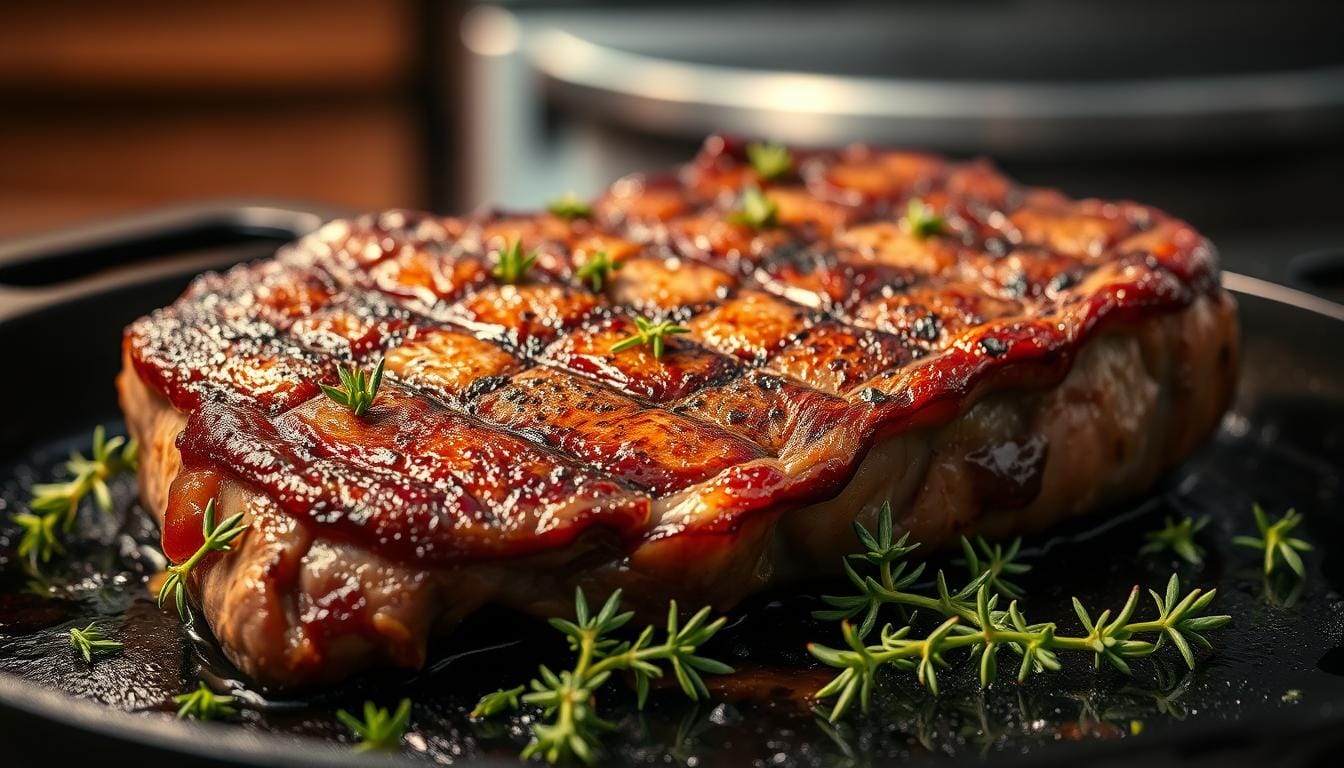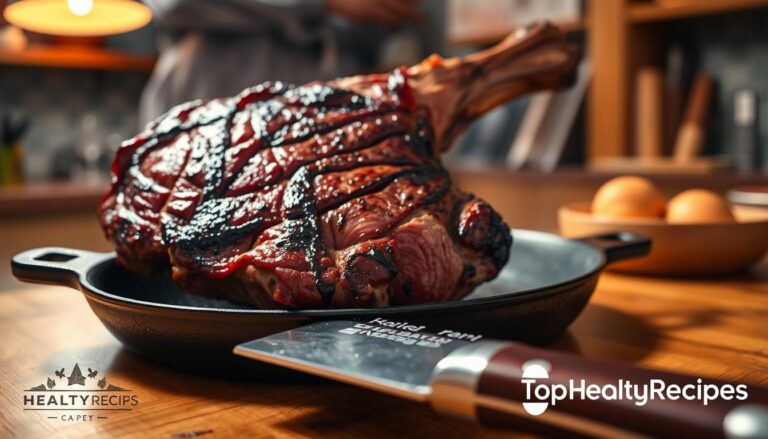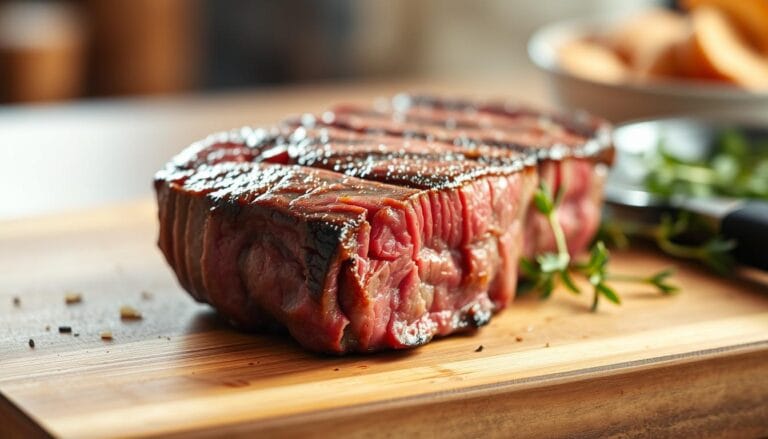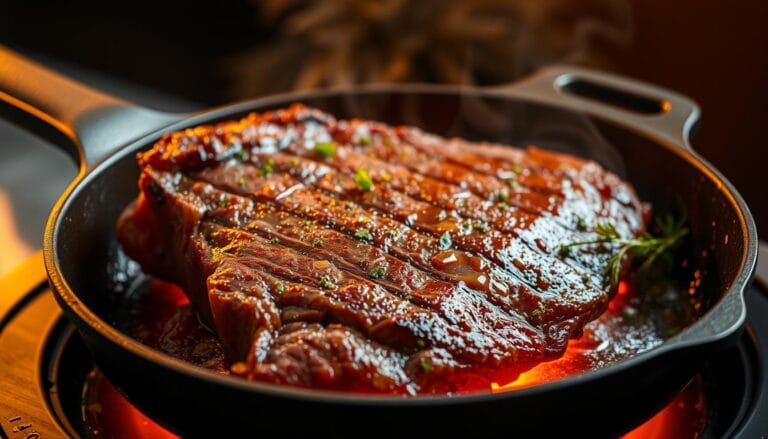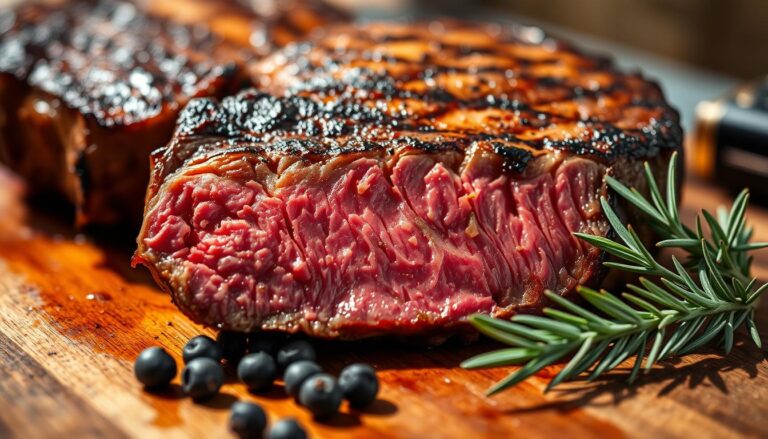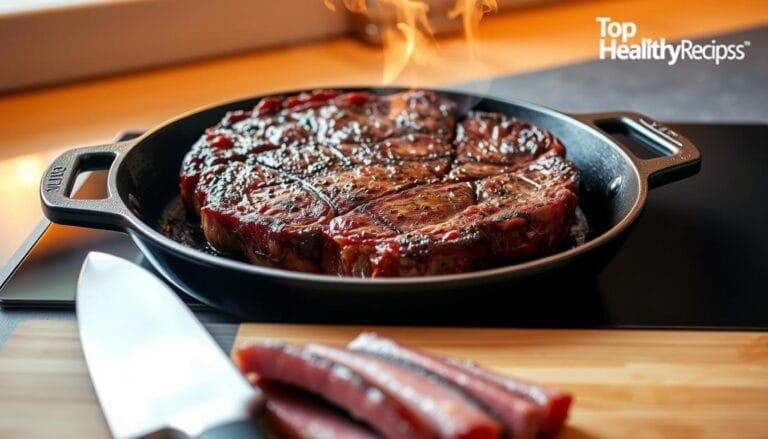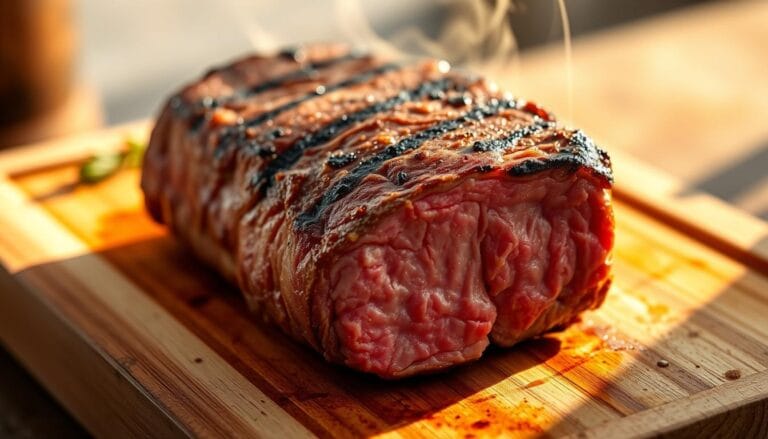How to Make Rump Steak That’s Tender, Juicy, and Full of Flavor
Table of Contents
How to Make Rump Steak That’s Tender, Juicy, and Full of Flavor
There’s something special about a perfectly cooked rump steak. It’s tender, juicy, and full of flavor. This makes for a truly satisfying meal. Whether you’re a seasoned chef or just starting out, you can achieve this quality.
You might have had tough or dry rump steaks before. But with the right techniques, you can make this affordable cut into a restaurant-quality meal. This guide will show you how, from picking the right cut to mastering cooking techniques.
Key Takeaways
- Selecting the right rump steak for tender results
- Understanding the importance of proper marination
- Mastering cooking techniques for juicy rump steak
- Tips for avoiding toughness in rump steak
- Enhancing flavor with simple seasoning and sauces
Understanding Rump Steak
Rump steak comes from the cow’s hindquarters. It’s known for its strong flavor and tender texture when cooked right. This cut is leaner, with a lot of flavor, thanks to its location near the hip and backbone.
What Is Rump Steak?
Rump steak is loved by beef fans for its rich taste and cooking versatility. It’s from the cow’s rear, making it tender and flavorful. The unique characteristic of rump steak is its perfect balance of tenderness and taste, making it a top choice for many dishes.
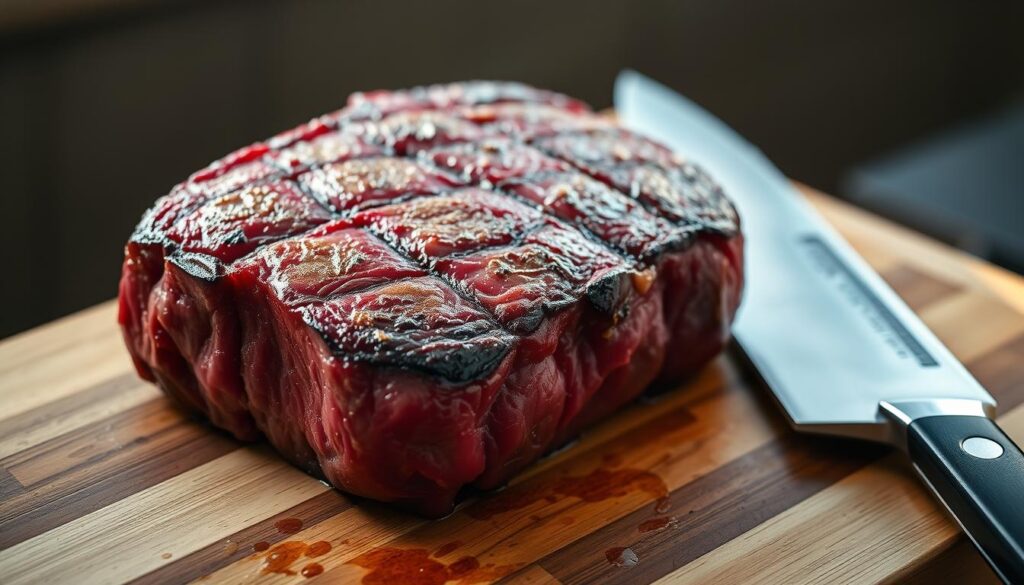
Nutritional Benefits of Rump Steak
Rump steak is not just tasty; it’s also full of nutrients. It’s an excellent source of protein, key for muscle repair and growth. It’s also packed with iron, zinc, and B vitamins, important for healthy red blood cells, a strong immune system, and energy.
| Nutrient | Amount per Serving | % Daily Value |
|---|---|---|
| Protein | 35g | 70% |
| Iron | 3mg | 15% |
| Zinc | 4mg | 25% |
| B Vitamins | Varies | 20-50% |
Cuts of Meat: Why Choose Rump?
Rump steak is a standout choice for its flavor, tenderness, and value. It beats other cuts like ribeye, sirloin, or filet mignon in many ways. Its leanness and rich beef flavor make it a great pick for a healthy yet tasty beef option.
In summary, knowing about rump steak means understanding its origin, nutritional perks, and how it stacks up against other beef cuts. With this info, you can pick and cook rump steak to its fullest.
Preparing Your Rump Steak
Getting your rump steak ready is key to a tender and tasty dish. It involves choosing the right cut and having the right tools.
Choosing the Right Rump Steak
When picking a rump steak, look for certain qualities. A steak with marbling is more tender and flavorful. It should be a deep red, showing it’s fresh. Also, a thicker steak cooks more evenly.
- Opt for a steak that is at least 1-1.5 inches thick.
- Check for any visible signs of aging or improper handling.
- Consider the origin and breed of the cattle for better flavor and quality.
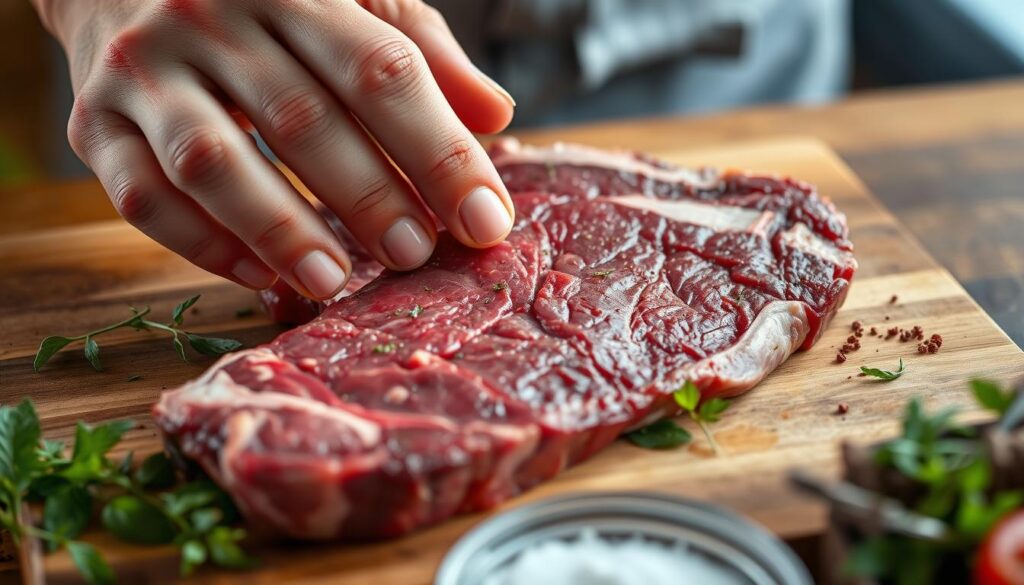
Necessary Tools and Equipment
Having the right tools is essential for cooking a perfect rump steak. You’ll need:
- A cast iron skillet or a heavy-bottomed pan for even heat.
- A meat thermometer to check the internal temperature.
- Tongs or spatulas for handling the steak.
- A sharp knife for trimming excess fat.
Thawing Frozen Rump Steak
Thawing a frozen rump steak safely is important. Here are a few ways to do it:
- Refrigerator Thawing: Place the steak in the fridge overnight. It’s safe and keeps the meat quality.
- Cold Water Thawing: Put the steak in a leak-proof bag in cold water. Change the water every 30 minutes. It’s faster but needs more attention.
- Avoid using the microwave, as it can cook the edges unevenly.
By following these steps, you’ll be ready to cook a delicious rump steak.
Marinating Your Rump Steak
Marinating your rump steak before cooking can greatly improve its tenderness and taste. It’s a simple method to boost your steak’s natural qualities.
Why Marinate?
Marinating does more than just add flavor. It tenderizes the meat and keeps it moist. Acidic ingredients like vinegar or citrus break down proteins, making the meat tender. Oil-based ingredients, on the other hand, keep the steak juicy and enhance its flavor.
The benefits of marinating include:
- Tenderization of the meat
- Enhanced flavor
- Moisture retention during cooking
Simple Marinades for Rump Steak
Making a marinade for your rump steak is easy. Here are a few simple recipes to try:
| Marinade Type | Ingredients | Flavor Profile |
|---|---|---|
| Classic Herb | Olive oil, garlic, thyme, rosemary | Traditional, aromatic |
| Asian-Inspired | Soy sauce, ginger, garlic, sesame oil | Savory, slightly sweet |
| Wine-Based | Red wine, olive oil, mustard, thyme | Rich, complex |
How Long to Marinate?
The marinating time affects your steak’s tenderness and taste. Marinating for 2 to 24 hours is usually best. But, the exact time depends on your marinade and steak thickness.
Acidic marinades work fast, so you might not need to marinate for long. But, oil-based marinades need more time to fully flavor your steak.
Seasoning Your Rump Steak
Seasoning your rump steak right can really boost its flavor. It’s not just about adding salt and pepper. It’s about making a flavor mix that goes well with the beef’s natural taste.
Choosing the Right Seasonings
There are many seasonings you can use for rump steak. You can go beyond salt and pepper. Try garlic powder, onion powder, paprika, and herbs like thyme and rosemary. Mix these to make a rub that you like.
- Garlic powder adds a savory flavor without the pungency of fresh garlic.
- Onion powder provides a sweet, savory taste that enhances the beef’s natural flavor.
- Paprika can add a smoky or sweet dimension, depending on the type used.
- Dried herbs like thyme and rosemary offer a fragrant, aromatic quality.
Best Salt and Pepper Techniques
Salt and pepper are key for seasoning steak. Choose kosher or sea salt for a better taste. Freshly cracked pepper is also better than pre-ground.
Dry brining can improve the steak’s texture and taste. Salt the steak and refrigerate it for a few hours before cooking. This method tenderizes the meat and brings out its flavors.
Adding Herbs and Spices
Herbs and spices can make your steak rub more interesting. Chop fresh herbs finely and mix them with spices. For dried herbs, just add them to your rub. Make sure to cover all parts of the steak evenly.
When to add herbs and spices matters. Avoid burning ingredients like garlic or certain herbs. Add them towards the end of cooking or use them in a sauce.
Cooking Techniques for Rump Steak
The secret to a tasty rump steak is in how you cook it. You can grill, pan-sear, or roast it. Each method has its own benefits and needs for the perfect doneness.
Grilling Rump Steak
Grilling adds a smoky taste and a nice char. To grill your rump steak well:
- Preheat your grill to high heat (around 450°F to 500°F).
- Use direct heat for a shorter cooking time to achieve a nice sear.
- For a 1-inch thick steak, grill for 4-5 minutes per side for medium-well doneness.
- Manage flare-ups by moving the steak to a cooler part of the grill if necessary.
Pan-Searing Rump Steak
Pan-searing gives a crispy crust and a tender inside. To pan-sear your rump steak:
- Heat a cast-iron skillet over high heat until it smokes.
- Add a small amount of oil with a high smoke point, such as avocado oil.
- Sear the steak for 2-3 minutes per side, then reduce heat to finish cooking to your desired doneness.
- Don’t overcrowd the pan to ensure even cooking.
Roasting Rump Steak
Roasting is perfect for larger cuts, cooking evenly. To roast your rump steak:
- Preheat your oven to 300°F to 325°F.
- Sear the steak in a hot pan before roasting to lock in flavors.
- Use a roasting rack to promote air circulation around the steak.
- Roast to your desired level of doneness, using a meat thermometer to check for internal temperatures.
Mastering these cooking methods will help you make a perfectly cooked rump steak. It will be tender and full of flavor. Whether you want it medium-well or another doneness, the right technique will make it delicious.
Cooking Times and Temperatures
To cook a rump steak that’s both tender and flavorful, you need to get the cooking time and temperature just right. Cooking rump steak to the correct internal temperature is key. This ensures you get the doneness you want, whether it’s rare, medium-rare, or medium-well.
Desired Levels of Doneness
The level of doneness is a matter of personal preference. It’s important to know the internal temperatures for each level. For rump steak, the temperatures are as follows:
- Rare: 120°F – 130°F (49°C – 54°C)
- Medium Rare: 130°F – 135°F (54°C – 57°C)
- Medium: 140°F – 145°F (60°C – 63°C)
- Medium Well: 150°F – 155°F (65°C – 68°C)
- Well Done: 160°F – 170°F (71°C – 77°C)
For a medium-well rump steak, aim for an internal temperature of 150°F to 155°F (65°C to 68°C). The thickness of the steak affects cooking time. Thicker steaks need longer cooking, while thinner ones cook faster.
Using a Meat Thermometer
A meat thermometer is a valuable tool for ensuring your rump steak is cooked to the correct temperature. There are various types of thermometers available, including instant-read and leave-in thermometers. To use a thermometer effectively, insert it into the thickest part of the steak, avoiding any fat or bone.
Instant-read thermometers provide a quick temperature reading, while leave-in thermometers can be left in the steak throughout the cooking process, allowing for continuous monitoring.
Resting Your Rump Steak
Once your rump steak is cooked to your desired level of doneness, it’s essential to let it rest. Resting allows the juices to redistribute throughout the steak, making it more tender and flavorful. To rest your steak, tent it loosely with foil and let it sit for 5-10 minutes.
“Resting is a critical step that many home cooks overlook. It’s not just about letting the steak sit; it’s about allowing the juices to redistribute, making every bite more enjoyable.” – Chef’s Insight
By following these guidelines for cooking times, temperatures, and resting, you’ll be able to achieve a perfectly cooked rump steak every time.
Serving Suggestions
Make your meal special by pairing your rump steak with the right sides and sauces. A well-cooked rump steak is great on its own. But, with the right dishes, it becomes even better.
### Side Dishes That Pair Well
Side Dishes That Pair Well
Choosing the right sides can make your rump steak taste even better. Trymashed potatoesandroasted vegetablesfor a comforting feel. For something lighter, afresh saladorgrilled asparagusis perfect.
If you want something different, trypolentaorquinoa. They add flavor and nutrition to your meal.
Sauces and Condiments to Enhance Flavor
The right sauce can really boost your rump steak’s flavor. You can make a quickpan saucewith the steak’s juices. Or, usechimichurri,peppercorn sauce, orbéarnaisefor a ready-made option.
Compound buttersadd a creamy touch to your steak.
### Plating Tips for Presentation
Plating Tips for Presentation
How you present your meal is important. Start byslicing your steak against the grain. Arrange the slices nicely on a plate.
Addingfresh herbsormicrogreenscan make it look even better. Make sure your steak is served at the right temperature. This affects both taste and texture.
By focusing on these details, you can make a memorable meal. It will highlight your perfectly cooked rump steak.
Storing Leftover Rump Steak
Storing leftover rump steak right is key to keeping it tender and flavorful. Whether you cooked too much or want to enjoy it again, proper storage is essential.
Proper Refrigeration Techniques
First, let the leftover rump steak cool down to room temperature. This stops bacteria from growing. Then, put it in an airtight container or wrap it tightly with plastic or foil.
Be sure to label the container with the date. Cooked rump steak can stay in the fridge for 3 to 4 days.
Food Safety Tip: Always check the steak for any signs of spoilage before consuming it, such as an off smell or slimy texture.
Freezing Leftover Steak
For longer storage, freeze your leftover rump steak. Wrap it tightly in plastic or foil, then put it in a freezer-safe bag. Remove as much air as possible to prevent freezer burn.
Freezer Storage Tip: Frozen rump steak is best consumed within 2 to 3 months for optimal quality.
Reheating Leftover Rump Steak
When reheating leftover rump steak, do it gently to avoid overcooking. Wrap it in foil and heat it in the oven at a low temperature until warmed through. Or, use a sous vide machine or reheat it on the stovetop with a bit of moisture.
Reheating Tip: Avoid microwaving as it can cause uneven heating and a less appealing texture. Consider turning your leftover steak into salads, sandwiches, or stir-fries for a creative meal.
Common Mistakes to Avoid
To get a tender and juicy rump steak, avoid common mistakes. Even skilled cooks can make errors that ruin the dish. Knowing these mistakes helps ensure your steak is perfect every time.
Overcooking Your Rump Steak
Overcooking is a big mistake with rump steak. It becomes tough and dry if cooked too long. This happens because the muscle fibers tighten and lose moisture.
To avoid this, cook your steak to the right doneness. For medium-well, remove it from heat when the internal temperature is 150°F to 155°F (65°C to 68°C). A meat thermometer is very helpful here.
Using Insufficient Seasoning
Not seasoning enough is another mistake. Rump steak needs good seasoning to enhance its flavor. Use about 1 teaspoon of salt per pound of meat.
But, timing is everything. Seasoning too early can make the meat too salty. Seasoning too late might not let the flavors mix well with the meat. Finding the right balance is key.
Best practice: Season your rump steak about 30 minutes to 1 hour before cooking. This lets the seasonings add flavor without overpowering the meat.
Skipping the Resting Period
Not letting the steak rest after cooking is another mistake. When you cook a rump steak, the juices move to the surface. Cutting into it right away lets these juices spill out, making it dry.
A simple test to determine if resting is complete: Gently press the steak; if it feels firm and springs back quickly, it’s ready. If it feels soft and squishy, it needs more time.
Health Considerations
Eating rump steak can be good for you if you know its nutritional value. It’s a great source of protein, vitamins, and minerals. Just remember to eat it in moderation.
Moderation and Balanced Diet
When you eat rump steak, keep an eye on the portion size. Aim for 3-6 ounces per serving. Adding vegetables and whole grains to your meal can make it more nutritious.
Nutritional Balance: A balanced diet is more than just controlling rump steak portions. It’s about eating a variety of foods. Include fruits, veggies, whole grains, lean proteins, and healthy fats in your diet.
Understanding Red Meat Consumption
Research shows that red meat, like rump steak, can be healthy in small amounts. Health groups advise limiting red meat to avoid health issues. Opt for leaner cuts like rump steak to reduce fat intake.
Tips for Healthier Cooking Methods
Choosing how you cook rump steak can make a big difference. Trim fat before cooking and use little oil. Grilling or broiling is better than pan-frying because it lets fat drip off.
Healthier Cooking Techniques: To make your rump steak healthier, marinate it before cooking. This adds flavor without extra salt or sugar. Letting the steak rest before slicing also helps keep it juicy and flavorful.
Pairing Beverages with Rump Steak
A great drink can make your rump steak dinner special. Whether you love wine, beer, or non-alcoholic drinks, there’s a perfect match for your rump steak recipes.
Best Wine Pairings
Wine lovers will find that rump steak pairs well with medium to full-bodied reds. Cabernet Sauvignon, Malbec, and Syrah are great choices. For a good deal, try a Cabernet Sauvignon from Napa Valley, priced around $40-$60. For a splurge, a Malbec from Mendoza can cost between $50-$100.
| Wine Type | Price Range | Region |
|---|---|---|
| Cabernet Sauvignon | $40-$60 | Napa Valley |
| Malbec | $50-$100 | Mendoza |
| Syrah | $30-$80 | Rhone Valley |
Beer and Rump Steak Combinations
Beer fans will enjoy porters, stouts, and amber ales with rump steak. These beers add roasted flavors that complement the steak’s richness. A robust porter or dark stout can elevate your meal.
“The key to pairing beer with steak is to consider the roast level and the body of the beer. A robust beer can stand up to the bold flavors of a well-cooked rump steak.”
Non-Alcoholic Options
For those who don’t drink alcohol, there are many tasty choices. Try a sparkling water with a squeeze of citrus or a unsweetened iced tea with herbs like mint or basil. A mocktail made with ginger beer and lime juice is also a great option.
Choosing the right drink can make your rump steak dinner even better. Whether you’re cooking how to make rump steak or just enjoying it, the right pairing is key.
Frequently Asked Questions
Cooking rump steak is an art that raises many questions. You might wonder about the best ways to make it tender and flavorful. This is true when trying out different recipes and cooking methods.
Can Rump Steak Be Cooked in a Slow Cooker?
Yes, you can cook rump steak in a slow cooker, which is great for tougher cuts. This method tenderizes the steak by breaking down connective tissues. To do this, add your favorite liquid (like stock or sauce) and cook on low for 8-10 hours. Adding vegetables and seasonings can also boost the flavor.
| Cooking Method | Cooking Time | Liquid Addition |
|---|---|---|
| Slow Cooker | 8-10 hours | Stock or Sauce |
| Grilling | 4-6 minutes per side | Marinade or Seasonings |
| Pan-Searing | 3-4 minutes per side | Oil and Butter |
How Do I Know When It’s Done?
To check if your rump steak is done, you can use a meat thermometer or the finger test. For medium-well, the internal temperature should be between 150°F and 155°F. If you don’t have a thermometer, press the steak gently. For medium-well, it should feel firm but soft to pressure.
What Should I Serve with Rump Steak?
Rump steak goes well with many sides, like roasted veggies, mashed potatoes, or a fresh salad. You can also add sauces like peppercorn or Béarnaise to enhance the taste. For a quick dinner, try it with sautéed spinach or grilled asparagus.
By answering these common questions, you’ll be ready to cook delicious rump steak that suits your taste.
Recipes to Try
Let’s explore some delicious rump steak recipes you can make at home. These recipes will help you improve your cooking and give you tasty meal ideas.
Classic Rump Steak Recipe
A classic rump steak recipe is always a hit. It’s easy, tasty, and great for any event.
- Ingredients: rump steak, olive oil, salt, pepper, garlic powder
- Instructions: Season the rump steak with salt, pepper, and garlic powder. Heat olive oil in a pan over medium-high heat. Sear the steak for 3-4 minutes per side, or until it reaches your desired level of doneness.
Rump Steak with Chimichurri Sauce
For a taste of Argentina, try pairing your rump steak with a fresh and zesty chimichurri sauce.
- Ingredients: rump steak, parsley, oregano, garlic, red pepper flakes, red wine vinegar, olive oil
- Instructions: Grill or pan-sear the rump steak as desired. While that cooks, mix parsley, oregano, garlic, red pepper flakes, and red wine vinegar to make the chimichurri sauce. Serve the steak with the sauce spooned over the top.
Asian-Inspired Rump Steak Stir-Fry
Turn your rump steak into a stir-fry with Asian flavors for a quick and tasty meal.
- Ingredients: rump steak, soy sauce, ginger, garlic, bell peppers, broccoli, sesame oil
- Instructions: Slice the rump steak thinly and marinate it in a mix of soy sauce, ginger, and garlic. Stir-fry the steak with bell peppers and broccoli in a hot wok. Finish with a drizzle of sesame oil.
These recipes show how versatile rump steak can be. Whether you want something classic or adventurous, there’s a recipe here for you.
Tips from Professional Chefs
Want a tender, juicy rump steak? Listen to professional chefs. They share their secrets for cooking beef rump to perfection. Follow their insights and techniques to improve your cooking.
Expert Insights on Cooking Perfect Rump Steak
Professional chefs stress the importance of knowing your meat. Rump steak, being lean, needs careful handling for tenderness. Proper cooking techniques and meticulous preparation are essential.
Experts say a key step is bringing the steak to room temperature before cooking. This ensures even cooking.
Chef-recommended Cooking Techniques
Chefs suggest several ways to improve rump steak’s flavor and texture. One method is butter basting. Melted butter is spooned over the steak, adding richness and moisture.
- Preheat your pan to a high temperature before adding the steak.
- Use a thermometer to ensure the steak is cooked to your desired level of doneness.
- Let the steak rest after cooking to allow the juices to redistribute.
Secrets to Tenderizing Rump Steak
Chefs offer several ways to tenderize rump steak. Mechanical tenderization, like slicing against the grain or using a meat mallet, is effective.
Another method is enzymatic tenderization. Ingredients like pineapple or papaya break down meat proteins.
- Marinate the steak using ingredients that contain enzymes known to tenderize meat.
- Use a meat mallet to gently break down the fibers.
- Slice the cooked steak against the grain to enhance tenderness.
By using these expert tips and techniques, you can cook a perfect rump steak. It will be tender and full of flavor. Try different marinades and cooking methods to find your favorite.
Conclusion: Mastering Your Rump Steak
Now you know how to make a great rump steak. It’s all about choosing the right cut, marinating it, seasoning it, and cooking it just right. Don’t forget to let it rest before you slice it.
Essential Tips for Perfect Rump Steak
For a tender and juicy steak, pick a cut with lots of marbling. Marinate it for at least 30 minutes. Then, cook it in a hot skillet or on the grill.
For medium-well, cook it to 150°F – 155°F. Letting it rest for a few minutes makes it even better. This way, the juices spread out, making it more delicious.
Experimenting with Your Rump Steak
Once you get the hang of it, try new things. Grill it with chimichurri sauce or pan-sear it with garlic butter. You’ll find your own way to make a perfect rump steak.
Share your creations and ask for advice. Start making your perfect rump steak today. Use the tips from this article to guide you.
FAQ
Can rump steak be cooked in a slow cooker?
How do I know when rump steak is done?
What should I serve with rump steak?
How long should I marinate rump steak?
What’s the best way to reheat leftover rump steak?
How can I tenderize rump steak?
What are the health considerations for consuming rump steak?
What beverages pair well with rump steak?
For more cooking tips, stay connected with us. We also recommend the cookbook Skinnytaste Simple: Easy, Healthy Recipes with 7 Ingredients or Fewer
For more Recipes about Steak ?
Did You try our recipe ?
There are no reviews yet. Be the first one to write one.
